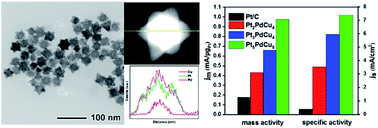Facile synthesis of ternary PtPdCu alloy hexapods as highly efficient electrocatalysts for methanol oxidation†
Abstract
Developing an efficient Pt-based multimetallic electrocatalyst with well-defined shapes for methanol oxidation reaction (MOR) is critical, however, it still remains challenging. Here we report a one-pot approach for the synthesis of ternary PtPdCu alloy hexapods with different compositions. Their MOR activities increased in the sequence Pt2PdCu4 < Pt3PdCu4 < Pt5PdCu5, and were substantially higher than that of commercial Pt/C. Specifically, the Pt5PdCu5 hexapods exhibited the highest mass (0.97 mA μgPt−1) and specific (7.39 mA cm−2) activities towards MOR, and were 5.4 and 19.4 times higher than those of commercial Pt/C (0.18 mA μgPt−1 and 0.38 mA cm−2), respectively. This enhancement could be probably attributed to the bifunctional mechanism and ligand effect through the addition of Cu and Pd as well as the unique dendritic structure. The better tolerance for CO poisoning also endowed the PtPdCu hexapods with superior durability relative to commercial Pt/C.



 Please wait while we load your content...
Please wait while we load your content...